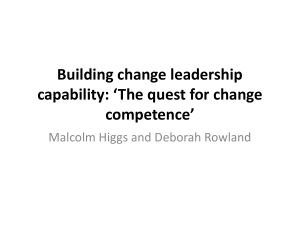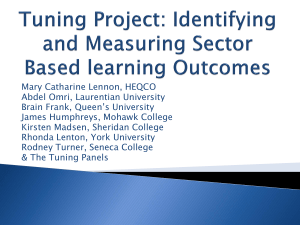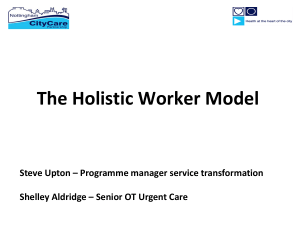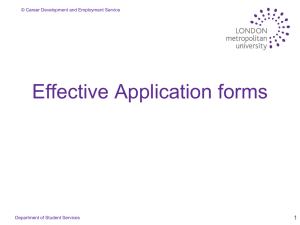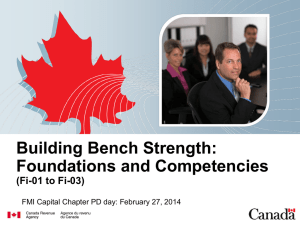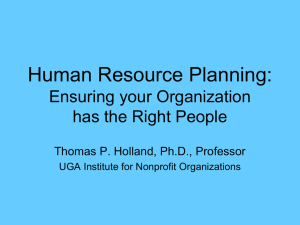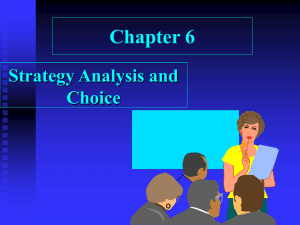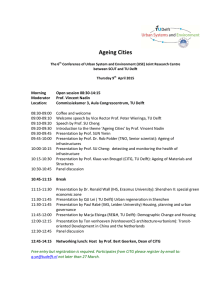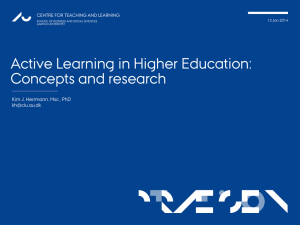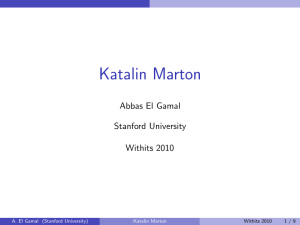Bridging unit part 3 - National Union of Teachers
advertisement
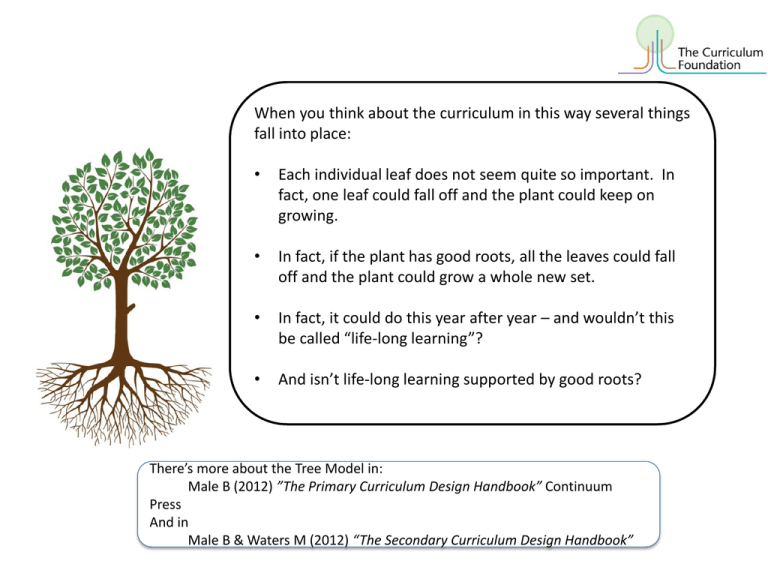
When you think about the curriculum in this way several things fall into place: • Each individual leaf does not seem quite so important. In fact, one leaf could fall off and the plant could keep on growing. • In fact, if the plant has good roots, all the leaves could fall off and the plant could grow a whole new set. • In fact, it could do this year after year – and wouldn’t this be called “life-long learning”? • And isn’t life-long learning supported by good roots? There’s more about the Tree Model in: Male B (2012) ”The Primary Curriculum Design Handbook” Continuum Press And in Male B & Waters M (2012) “The Secondary Curriculum Design Handbook” So the question is, What happens in the trunk to link the leaves to the roots? The trunk is the ‘quality of pupils’ learning experiences’ – and this is the key to successful curriculum design. In order to develop the competencies within the context of subject knowledge, we need to engage pupils in active approaches to learning in which they have opportunities to investigate, think critically and co-operate with others to solve problems. This cannot be achieved whilst learners are sitting passively listening to their teacher. So the development of the competencies makes learning more active – and more engaging. Who were these two? Did you recognise them? And what do they have to do with this? They are Ference Marton and Roger Säljö of Gothenburg University In 2008, Marton and Säljö considered “Deep and Surface Approaches to Learning” and saw three levels, which they likened to coffee moving through the cafetiere to make the final brew. This is an interesting metaphor, because we often try to speed up the coffee process by trying to ram it down with the plunger – but when it is ready it sinks of its own accord. Then all you have to do is rest your finger on the plunger and it sinks gently. And you get much better coffee if you wait for it to have infused properly! This might conjure up an image of unfortunate students having learning rammed down their throats, when the teacher would be better advised to give them time to absorb their learning and to let it sink in. The ramming down their throats will not make good learning anyway. Marton and Säljö’s “Three Levels” When you look at these three levels, you see that we are moving through Bloom’s Taxonomy (down, not up this time! Bloom saw things as getting higher, Marton and Säljö as getting deeper). You also see that the deeper levels are very akin to the application of the competencies. Earlier on, we asked who this was. Did you know? It’s Emma Simms, now of Northampton University but formerly of Head of Innovation at the Specialist Schools and Academies Trust. In 2006 she authored the SSAT publication: “Deep Learning – a new shape for schooling” Together with “Deep Learning 2” authored by David Hargreaves, Sims puts forward a cycle of learning and argues that deep learning is brought about by the greater involvement of the learner in the process, so that they become active agents in their own learning. This greater involvement comes about when pupils are asked to investigate things for themselves, to think about them, solve problems and work with others. This requires particular approaches to curriculum design and also to teaching. It requires the building in of the competencies. So, what is the implication of this for assessment? (This is the second implication mentioned above) Well, if we are promoting deep learning through the development of competencies, then we need to take account of this in assessment. And if deep learning can be promoted through competencies, then we will be able to assess subject progress at a competency level. This will take account of the deeper levels of learning. This is not new or innovative. In fact, if you look at the old Level Descriptions, you will see that many were written at this level anyway – as are present GCSE requirements. © Curriculum Foundation And how does all this fit with the new National Curriculum? It may seem at first that it does not fit well at all. Or will cause a great deal of work and trouble. But it could be the element that brings the curriculum to life and makes it engaging and worthwhile. And it could even make assessment much easier! More about this in Unit 2. © Curriculum Foundation So, there might well be life beyond the levels. And if we get it right, it might even be a much better life. The next five units will take us through approaches that will help us adapt and make life not only better – but easier too! Here’s one more person to recognise before we finish: © Curriculum Foundation Do you recognise the man below? It’s Howard Gardner of “Learning can be ‘Multiple Intelligences’ undone fame. if the curriculum is too This is what he said about rigid”the curriculum: (Howard Gardner 1999) We need to move away from rigidity in the curriculum – and in assessment too. This is what we shall be looking at in the next set of units. We are now at the end of this Bridging Unit – so there has to be some homework! Think back to the lists of competencies we looked at, and then try to make your own list for your class or school. Now take an element of the Programme of Study or syllabus you are going to teach this term, and design a learning experience that would put the two together. (There are some examples in Unit 2 of Programme 1) It does not have to be elaborate. It just has to involve young people developing some of the competencies that you listed. This will deepen subject learning and almost certainly make it more engaging. It might even make learning irresistible! Try it out – and let us know what happens… In the next units we shall look at ways of assessing that learning. So that’s it for this unit. There were two key implications for assessment: • Wider aspirations need wider assessment • Competencies will need a different approach, but might make the job easier Now, here are the answers to the face recognition questions. © Curriculum Foundation How many did you recognise? John Biggs Benjamin Bloom Prof Lorna Earl ED Hirsch Prof Mark Zelman Prof Laura Greenstein . Ference Marton Roger Säljö Prof Anna Craft Dylan William Prof Sheila Valencia © Curriculum Foundation Norman Webb 14 Prof David Hargreaves Andreas Schleicher Prof Usha Goswami Emma Simms Michael Fullan Brian Male WB Yeats Dr John Rutayisire Sir Ken Robinson Prof Mick Waters How many did you get right? © Curriculum Foundation 15 And here are some definitions of the curriculum. © Curriculum Foundation Definitions of “Curriculum” “Think of the curriculum as a forecast of possibilities within an arena of opportunities” Carla Rinaldi Head of the Reggio Emilia Schools In Italy Definitions of “Curriculum” “The curriculum is about our culture, life, identity and survival, what we want to be and where we want to go.” Dr John Rutayisire Director General for Curriculum, Rwanda Definitions of “Curriculum” “All the planned learning experiences students receive during their time at school.” Mick Waters Director of Curriculum England Definitions of “Curriculum” “When a nation sets out its national curriculum, it is setting out its ambitions for the future.” Jerome Bruner Definitions of “Curriculum” “The school curriculum needs to prepare the nation’s young people for an ever-changing future” (He needs no introduction!) Bridging Unit Coming to terms with the new National Curriculum The author of might this unit isthe from Bristol and just wished toSAT share Some schools see bridge as a symbol of their or Why was the Suspension Bridge here? this imageIfwith all!the And it is aofbridge, after all.from GCSE scores. you you follow curves the supports which the bridge is suspended, they go up and down, up and down! But all the time they are giving good support to the road beneath and keeping it straight and steady! © Curriculum Foundation
